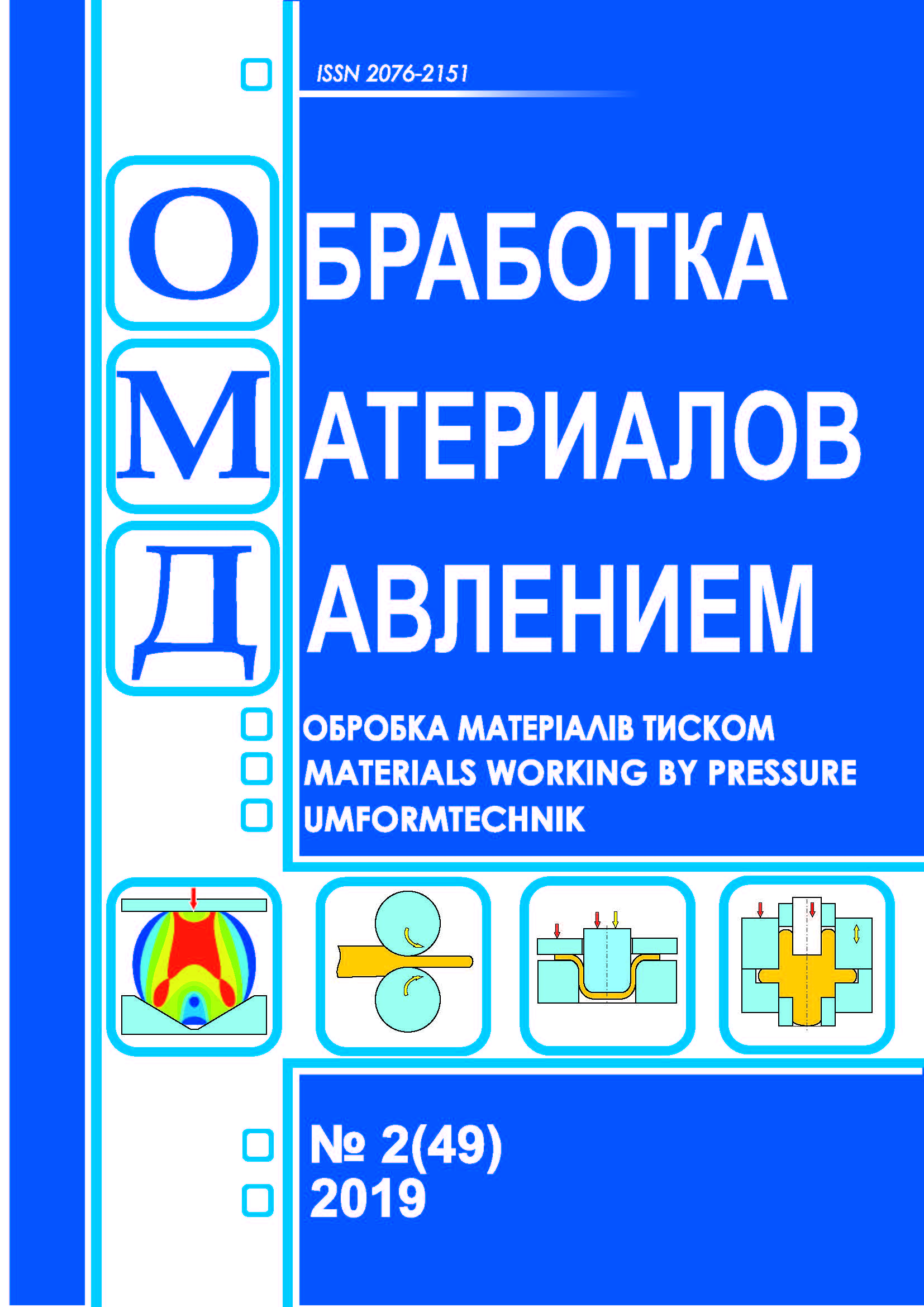Shaping of parts with branches such as feather by the method of combined extrusion
DOI:
https://doi.org/10.37142/2076-2151/2019-2(49)106Keywords:
extrusion; parts with inclined branch; finite element method; power mode; stress state; shaping.Abstract
Aliiev I. S., Abhari P. B., Kordenko M. Yu., Savchenko O. K. Shaping of parts with branches such as feather by the method of combined extrusion // Material working by pressure. – 2019. – № 2 (49). - Р. 106-113.
The extrusion process of hollow part with branch such as «feather» from aluminum alloy (AD1) has been simulated by finite element method. The aim of the investigation was to study the power mode and the features of the shaping in lateral extrusion processes with angled branch parts to make the form of feathers. The effects of quantity and thickness branch in power mode, stress strain state and regularities of shaping parts such as this type of part depending on the technological scheme in the extrusion process have been considered. The diagram «force - stroke» in extrusion process with branch in feather part has been characterized by the presence of several stages. At the initial stage, metal compression in the matrix, the transition to the metal flow into branch in the lateral extrusion process and the formation of a cylindrical cavity with increasing the deformation force has been occurred. At the second stage, the combined metal flow, power parameters increase as smooth form have been observed. At the final, third stage of the process, sharp increase extrusion forces have been showed that is explained by the transition to the stationary stage of metal compression on a thin jumper or the thickness of the part bottom. It has been considered that an increase in the quantity of lateral (inclined at an angle of 600) feathers from two to six are accompanied by a decrease in deformation forces by 43 %. The effect of the feather thickness in the power mode is also significant: a three-fold decrease in the thickness of the feather (from 3 to 1 mm) causes an increase in extrusion force of up to 45 %. Indicators of the stress-strain state in workpiece during extrusion have been distributed relatively evenly throughout the part, but it can be noted that maximum in the places of transition from the cylindrical part to the region of transverse branches. Experimental investigations have been confirmed qualitatively and quantitatively the results of a computer analysis in the power mode and the regularity of the shaping part. To shape a clear contour of the feathers, it is necessary to perform lateral extrusion in a separate stage of the combined process.
References
Evstratov V.A. Fundamentals of extrusion technology and the design of dies. Kharkov: High school. 1987, 144 p. (in Russian).
Ovchinnikov A.G. Fundamentals of the theory of stamping extrusion on presses. Moscow: Mechanical Engineering. 1983, 200 p. (in Russian).
Avdeev V.M., Aksenov L.B., Aliiev I.S., et al. Production of Blanks and Parts by Plastic Deformation. Eds. Bogoyavlensky K.N., Ris V.V.. Leningrad: Politehnika, 1991, 351 p. (in Russian).
Aliiev I.S. Technological processes of cold transverse extrusion. Forging and stamping production. 1988, 6, pp. 1–4. (in Russian).
Pat. 662223 USSR, MKI B21 J5/00. The method of extrusion of metal products. Aliiev I.S. 1979.
Paltasingh U.C., Sahoo S.K., Das P.R., Nayak K.C., Potnuru S. Lateral Extrusion for Round to-Triangular Head: Experimental Studies and Three Dimensional Analyses. International journal of research in aeronautical and mechanical engineering. 2013, 1, 2, pp. 1-8.
Stefan Rudolf. Hollow lateral extrusion – a newly developed cold forging process Access mode: http://www.umformtechnik.net/binary_data/154121_hollow_lateral_extrusion_stuttgart_rudolf_ifu_stuttgart.pdf.
Aliiev I.S. Technological capabilities of new methods of combined extrusion. Forging and stamping production. 1990, 2, pp. 7–10. (in Russian).
Aliіev І.S. Methods of trying new technological abilities of seeing. The theory of this practice obrobki materialiv tiskom: a collective monograph. Eds. Boguslaev V.O., Bobir M.І., Tіtov V.A., Kachan O.Ja. Zaporizhzhya: JSC “Motor Sich”. 2016, pp. 364–385. (in Ukrainian).
Basjuk S.T. Production of complex forgings in stamps with split dies. Forging and stamping production. 1973, 7, pp. 8-11. (in Russian).
Aliieva L.I. Processes of combined deformation and extrusion. Materials working by pressure. Kramatorsk: DSEA, 2016, 1(42), pp. 100–108. (in Russian).
Aliieva L.I. Improving the processes of combined extrusion: monograph. Kramatorsk: Ltd.”Tirazh–51“, 2018, 352 p. ISBN 978-966-379-846-2. (in Russian).
Aliieva L., Zhbankov Y. Radial-direct extrusion with a movable mandrel. Metallurgical and Mining Industry, 2015, 11, pp. 175–183.
Aliieva L.I., Titov A.V., Kordenko M.Ju. Modeling of lateral extrusion processes. Material working by pressure. Kramatorsk: DSEA. 2019, 1 (48), pp. 35-44. (in Russian).
Abhari P. The investigation of lateral extrusion process using finite element simulation. International Journal for Research in Applied Science and Engineering Technology. 2017, 5, pp. 1703–1707.
Savchenko O.K. Zhukova O.A. Lateral extrusion of body parts with branch. Material working by pressure. Kramatorsk: DSEA. 2013, 1 (34), pp. 96-99. (in Russian).

